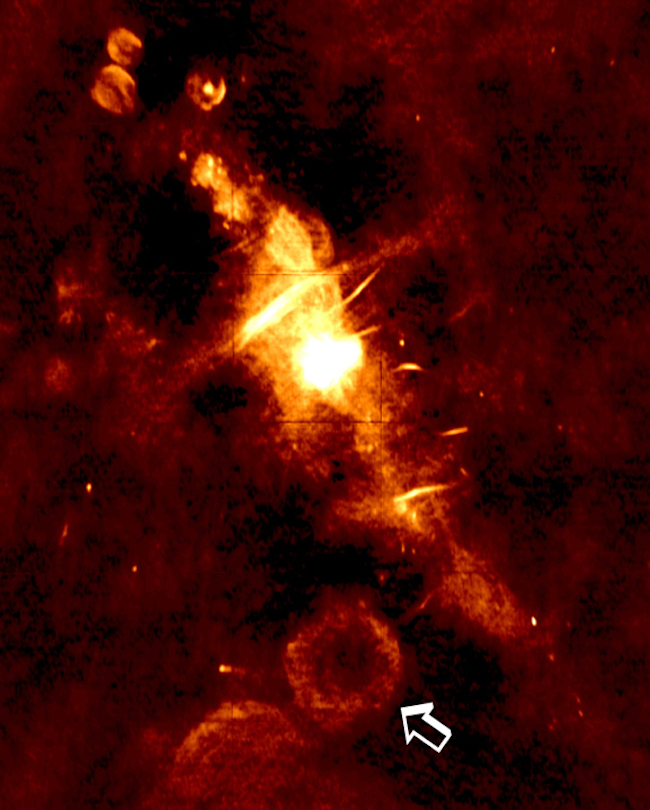
Weird radio waves from an unknown source
Radio emission is common in the universe. They’re generated by everything from planets and stars – exotic objects like pulsars and black holes – galaxies – and, of course, human technology. This week (October 12, 2021), astronomers said they’ve detected new and unusual radio wave signals, unlike any found before. The radio waves are coming from the direction of the center of our Milky Way galaxy. And so far, scientists haven’t explained them.
Astronomers discovered the variable signals using the ASKAP radio telescope in Australia. The behavior of the radio emission doesn’t fit the pattern of any known source of radio signals. It might be a new kind of stellar object, the scientists said.
Ziteng Wang in the School of Physics at The University of Sydney led the international team of astronomers from Australia, Germany, the United States, Canada, South Africa, Spain and France who observed the signals. They published their peer-reviewed paper about the intriguing discovery in The Astrophysical Journal on October 12.
Variable signal with unknown pattern
The source of the signals has been dubbed ASKAP J173608.2-321635, but astronomers don’t know what the source actually is. It is located in the direction of the center of our Milky Way galaxy. Wang said:
The brightness of the object […] varies dramatically, by a factor of 100, and the signal switches on and off apparently at random. We’ve never seen anything like it.
Whatever it is, it is highly polarized and oscillates, as Wang explained:
The strangest property of this new signal is that it is has a very high polarization. This means its light oscillates in only one direction, but that direction rotates with time.
See an animated representation of the radio signals in the video below:
From invisible to visible and back again
One of the most extraordinary things about the source is how it was found. Tara Murphy from the Sydney Institute for Astronomy and the School of Physics said:
We have been surveying the sky with ASKAP to find unusual new objects with a project known as Variables and Slow Transients (VAST), throughout 2020 and 2021. Looking towards the center of the galaxy, we found ASKAP J173608.2-321635, named after its coordinates. This object was unique in that it started out invisible, became bright, faded away and then reappeared. This behavior was extraordinary.
The astronomers detected six signals over a period of nine months in 2020. But, when the astronomers tried to find the source in visual light, using optical telescopes, they saw nothing. The Parkes radio telescope in Australia also came up empty.
But then, the MeerKAT radio telescope in South Africa, an array of telescopes more sensitive than Parkes, did detect it. The signal was there, albeit intermittent and different. Murphy described the signal:
Luckily, the signal returned, but we found that the behavior of the source was dramatically different. The source disappeared in a single day, even though it had lasted for weeks in our previous ASKAP observations.

What could the source of the weird radio waves be?
Wang and his team ruled out that it might be a pulsar, a rapidly spinning neutron star that emits lighthouse-like beams of energy:
At first we thought it could be a pulsar – a very dense type of spinning dead star – or else a type of star that emits huge solar flares. But the signals from this new source don’t match what we expect from these types of celestial objects.
The signals also appear to be different from those generated by such objects as supernovae, flaring stars and fast radio bursts (FRBs). Those objects are also variable, but sorry, no match to the newly discovered oddity.
However, there do seem to be some similarities with other mysterious sources near the galactic center called Galactic Center Radio Transients (GCRTs). David Kaplan at the University of Wisconsin-Milwaukee explained:
The information we do have has some parallels with another emerging class of mysterious objects known as Galactic Center Radio Transients, including one dubbed the ‘cosmic burper’.
While our new object, ASKAP J173608.2-321635, does share some properties with GCRTs, there are also differences. And we don’t really understand those sources, anyway, so this adds to the mystery.

Next steps
The discovery is a puzzling mystery for scientists, and naturally, they want to figure it out. So what comes next? The researchers plan to continue monitoring the signals as much as they can. In addition, they will get help with that task, thanks to a new powerful radio telescope being built. According to Murphy:
Within the next decade, the transcontinental Square Kilometre Array (SKA) radio telescope will come online. It will be able to make sensitive maps of the sky every day. We expect the power of this telescope will help us solve mysteries such as this latest discovery, but it will also open vast new swathes of the cosmos to exploration in the radio spectrum.
In the meantime, scientists will keep listening with current telescopes, in hopes of finding more clues. Whatever this enigma turns out to be, it will provide exciting new insights about our universe.
Bottom line: An international team of astronomers has detected weird radio waves coming from the heart of the Milky Way. They are unlike any found before, and may originate from a new type of cosmic object.
Via the University of Wisconsin-Milwaukee
The post Weird radio waves from the heart of the Milky Way first appeared on EarthSky.
0 Commentaires